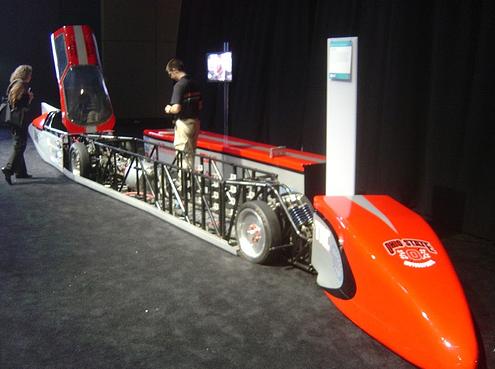Archive for the 'Transportation' Category
Move over Tesla…
Here comes the Buckeye Bullet.

OK, it’s not a fair comparison, Tesla is a road worthy electric vehicle and the Buckeye Bullet is a single purpose speed machine. Back in 2004, the Buckeye Bullet 1 set and still holds the land speed record for electric vehicles at 315 mph (506 kph) at Bonneville Salt Flats. The Ohio State University College of Engineering is at it again this time attempting to build a hydrogen powered vehicle, the Buckeye Bullet 2, to attempt to set more records in August, 2007.
Who says clean can’t be fast? Comments are off for this post
Great Green Car Review

Lexus GS-450h
UK company VCARS published a very informative article on hybrids and electric vehicles this week:
Hybrid Cars
The most common hybrids available on the market today use a combination both petrol combustion engines and electric motors.What are ‘Hybrid’ cars?
In simple terms, these are cars that use both electric motors and petrol combustion engines. The petrol engine charges the battery when using regenerative braking and during higher speeds. The battery operates the car at low speeds or in traffic, whilst the petrol engine cuts-in at higher speeds, therefore allowing the car to operate efficiently.The combination of the petrol combustion engine and battery power tend to produce less CO2 and pollution. Hardly any gases are released into the atmosphere when the electric motor is running. Therefore, hybrid cars are often exempt from the London congestion charge, as well as qualifying for cheaper car tax.
A very encouraging aspect of this article is the variety of green vehicles available now, and the pipeline on the way. Now, if we could only convince the designers not to make these vehicles so “distinctive” – a regular car with good fuel efficiency and performance would do.
1 comment
Mobilizing the median
From the Salt Lake Tribune:
KAYSVILLE – Seeds planted Tuesday along a strip of Interstate 15 could someday fuel state trucks and snowplows, reduce the need for mowing, allow the use of less-harmful herbicides and grace otherwise weedy roadsides with blue, red and yellow flowers.
Utah State University and the Utah Department of Transportation are teaming up on an experiment to sow about a mile of grassy safety strips around the state with plants whose seeds can be crushed and processed into 100 percent biodiesel. UDOT will use the homegrown fuel to replace the conventional diesel in state vehicles.
The unusual idea came from Dallas Hanks, a 44-year-old biologist who is working on his doctoral degree at USU. With an initial $50,000 boost from UDOT, Hanks aims to prove the 2,500 miles of state-owned highway right-of-way could yield an annual average of 500,000 gallons of 100 percent biodiesel, also known as B100.
Hanks, a former Utah Valley State College biology instructor, said he conservatively estimates planting swaths of safflower, camelina, canola and perennial flax will save about $1.6 million per year in mowing costs. UDOT officials said they wouldn’t know the total taxpayer savings until the project’s first-year experiment is finished.
This is an interesting approach to growing feed stock for biofuels that won’t displace current food crop capacity. We’ll see how it works, but the creativity in approach is to be applauded.
Comments are off for this post
Don’t just boycott, take real action for change
As you may have heard, today, May 15th is the national gas boycott day. It’s a great attention ploy and maybe even an interesting symbol of protest. But in the end, all it will do is defer sales until later in the week.
What’s required to really move prices? A change in behavior. If each driver in the US would do the following things over the next year, it could reduce fuel demand by as much as 10%.
The easiest actions you can take to increase your fuel efficiency by 10%:
- Drive the speed limit, the faster you go, the more fuel you burn (and your ticket risk goes down) this yields around 5% fuel efficiency
- Remove unnecessary items from your car, each 100 lbs of weight removed can add up to 2% fuel efficiency
- Don’t idle your car unnecesarily, for any delay longer than a stop light, switch the ignition off
- Whenever you make a trip, combine multiple segments into one eliminating the need for mulitple trips
- Take it easy, hot rod starts and fast braking can decrease fuel efficiency by as much as 33%.
Easy suggestions to increase your fuel efficiency by 10%
- Make sure your tires are properly inflated, wheels balanced, and aligned this will yield around 3% fuel efficiency
- Ensure your car has a clean air filter which could yield up to 5% fuel efficiency
- Keep your car “tuned up” which will yield up to 4% fuel efficiency
- Use the right grade of motor oil, this will yield up to 2% fuel efficiency
More suggestions to increase your fuel efficiency by 10%
- If you must commute, carpool or take public transport
- Buy a more fuel efficient car, a 10mpg difference could save as much as $3,000 per year in fuel
- Avoid “rush hour” travel
- Telecommute to work
Obviously, these suggestions range in cost and effort from essentially zero (change your driving behavior and remove excess weight) to very expensive (buy a more fuel efficient car.) We publish all of them so you can select the actions you want to take to actually change the fuel comsumption over time rather than simply boycotting gas purchase for a day. Not everyone can do everything on this list, but everyone can do some combination of these items to total a 10% reduction. Let’s focus our effort on these pragmatic actions and we’ll see an impact on the price of gas, save yourself money, and oh by the way, we’ll reduce our greenhouse emissions as a bonus.
Comments are off for this post
Smuggled alcohol and animal remains to biofuel

From Sweden.se:
Swedes could soon be filling their cars with smuggled alcohol and animal remains. It is all part of a plan by the Swedish government to wean the country off oil within 15 years and thereby become the world’s first oil-free country…
…The one million bottles and cans seized annually by Tullverket are trucked to a warehouse where they are dumped into a crushing machine. The beverages are separated from their containers and blended with water to make the largest and probably worst-tasting cocktail imaginable. This is then taken by tanker to a plant in Linköping, about 200 km south of Stockholm, and turned into biofuel to power public buses, taxis, garbage trucks, private cars – even a train…
…Peter Undén is the marketing boss at SvenskBiogas, which produces, distributes and sells biogas for transportation in eastern Sweden. Each year the company takes 50,000 tons of a stomach-churning mixture of slaughterhouse waste, human waste and seized alcohol and turns it into clean-burning biogas…
It’s always interesting to see where policy coupled with a little innovation can produce. One must admire the Swedish government’s goal, 100% oil independence in 15 years. This is certainly a novel approach to the production and use of biofuels.
Comments are off for this post








